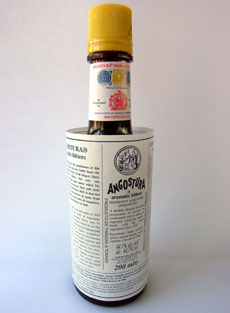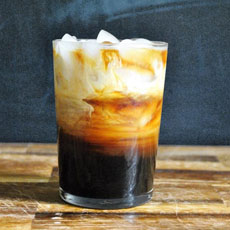TIP OF THE DAY: Try Bitters In Your Coffee & The History Of Bitters
|
Many “cocktail households” have a bottle of Angostura bitters, to splash into a Manhattan or other recipe. In fact, you can add bitters to still or sparkling water, regular or diet soda, hot or iced tea, and coffee. (There’s a recipe for iced coffee with bitters below.) If you follow food and beverage trends, you’ve no doubt seen the Renaissance in artisan bitters. In America, bitters had traditionally meant the ginger-tasting Angostura* bitters (it’s actually made with gentian root, a different botanical family) and the sweeter and more aromatic Peychaud’s Bitters (also gentian) used in the Sazerac cocktail of New Orleans. In recent years, flavors of bitters have been introduced by specialty foods companies, ranging from Bittermens Hopped Grapefruit Cocktail Bitters, Fee Brothers Aztec Chocolate Cocktail Bitters, Fee Brothers Grapefruit Bitters, Hella Bitters Smoked Chili Cocktail Bitters, Stirrings Blood Orange Cocktail Bitters, and dozens more flavors producers. So… Bitters, which date back to ancient Egypt, are liquids consisting of water, alcohol, and botanical extracts. These botanicals—aromatic herbs, barks, flowers, fruits, and roots—were known for their medicinal properties. Popular botanicals included cascarilla, cassia, gentian, orange peel, and cinchona bark. The word bitters derives from Old English biter, which evolved thousands of years earlier from the Gothic baitrs, “to bite,” describing the taste of numerous botanicals. The Middle Ages saw an increase in the development of medicines that combined botanicals with alcohol to create tonics, often used to aid digestion (hence the term, digestive bitters, as opposed to the modern “cocktail bitters”). Available “over the counter,” they came to be used as preventive medicines. By the turn of the 19th century, the British practice of adding herbal bitters to wine had become very popular in the U.S. as well. What happened next? By 1806, there are American references to a new preparation, the cocktail, described as a combination of “a stimulating liquor, composed of spirits of any kind, sugar, water, and bitters.” At the end of the 20th century, with the evolution of modern mixology, creative bartenders began to create bitters from new ingredients, to add different flavors to their drinks. Artisan producers sprang up, and now a great gift for any home mixologist is a set of flavored bitters. It is well known that the people of New Orleans (the actual name is New Orleanians) add chicory to create a bitter flavor in their coffee. Why not try some bitters? A drop of bitters perks up the brew whether you drink your coffee black or with milk and/or sugar. Try it and see! Start with just a few drops (we began with one drop). You can add more to taste. Here’s a recipe for iced coffee with bitters from Hella, using its standard aromatic bitters. Yes, start with the traditional before moving on to Aztec Chocolate or Smoked Chili bitters. Consider topping an iced coffee with bitters whipped cream (recipe in footnote)†! Ingredients Per Cup |
|
|
|
Preparation 1. COMBINE the ingredients in a glass. Stir gently, taste, and adjust the sugar or bitters to your taste. 2. GARNISH as desired and serve. Check out this article from BonAppetit.com, which includes everything from baking and fruit salad, ice cream, floats, and whipped cream. *Despite its name, Angostura brand bitters are not made from the bark of the angostura tree but from the gentian root. The name comes from the town of Angostura, Venezuela (known today as Ciudad Bolívar). There, in 1824, a German physician, Johann Gottlieb Benjamin Siegert, compounded a cure for seasickness and stomach maladies. It worked, and Dr. Siegert subsequently formed the House of Angostura to sell his bitters to sailors. Bitters whipped cream recipe: This recipe uses just 1/2 cup cream and makes a smaller amount than you’d be used to if you typically whip a full cup of cream. Of course, you you can easily double it. Combine ½ cup chilled heavy/whipping cream into a bowl with 1 to 2 teaspoons of light brown sugar (you can substitute plain). Add 12 dashes of Angostura bitters and whip as usual (we use electric beaters). |
||





